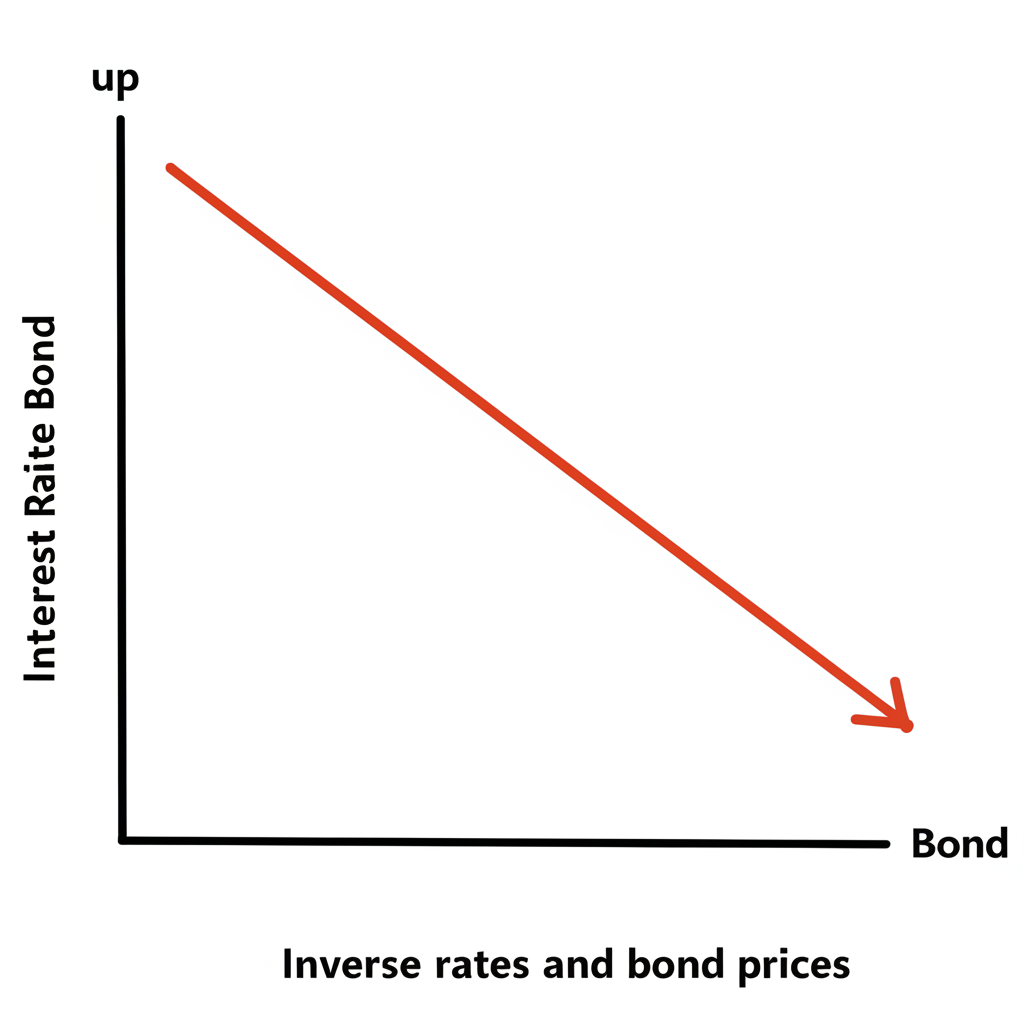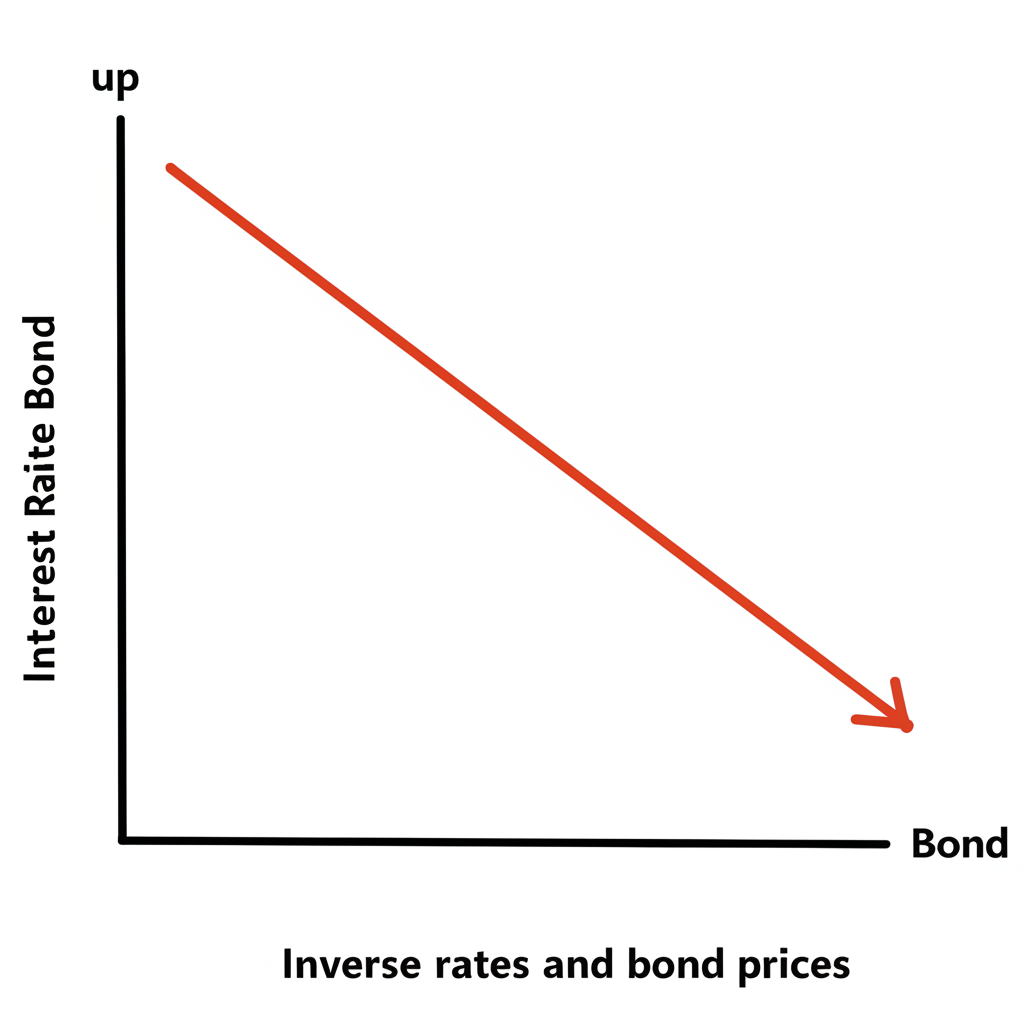Introduction: Unpacking the Interest Rate-Bond Relationship for US Investors in 2025
The bond market has long served as a reliable foundation for many investment portfolios, yet it has faced notable ups and downs in recent times, especially within the United States. With the Federal Reserve tweaking its approach to monetary policy amid shifting economic conditions, bond prices and yields have fluctuated widely, leading countless American investors to rethink their strategies for fixed-income assets. Heading into 2025, getting a solid handle on how interest rates and bonds interact isn’t just helpful-it’s a must for protecting and building your investments. In this guide, we’ll break down the basic ways rate changes affect bond values, look ahead at the main influences shaping the US market, and share actionable insights and tactics to help you steer through the changing financial terrain.

The Fundamental Inverse Relationship: Why Bond Prices Fall When Interest Rates Rise
Central to investing in bonds is a key idea that might seem backward at first: bond prices usually head in the opposite direction of interest rates. As rates climb in the market, the prices of bonds already out there tend to drop, and when rates ease, those prices climb. This push-and-pull is something every US investor needs to understand thoroughly.
Understanding Bond Basics: Principal, Coupon Rate, and Maturity
To get why this inverse link exists, start with the essentials of bonds in the American setting. At its core, a bond represents a loan from you, the investor, to an issuer like the US government, a local municipality, or a business. In exchange for your funds, the issuer agrees to repay the initial amount-the principal, or face value-on a set future date called maturity. Along the way, they make periodic interest payments based on the coupon rate, which is typically disbursed every six months.
The Role of Present Value and Opportunity Cost
This back-and-forth relationship boils down to present value and the idea of opportunity cost. Picture this: You purchased a US Treasury bond a year ago carrying a 3% annual coupon. Then the Federal Reserve hikes rates, and fresh Treasury bonds come out offering 4% coupons.

That older 3% bond suddenly looks less appealing next to the new 4% options flooding the market. If you want to offload it, you’d have to slash the price below face value to draw buyers, adjusting the yield to match the higher rates now available. This gap in appeal highlights the opportunity cost for anyone considering the purchase. Bonds with longer time until maturity feel these rate shifts more intensely, since more of their future payments get recalculated in present terms.
To make it concrete, consider a straightforward example tailored to the US market:
Take a bond with a $1,000 face value and a 3% annual coupon, set to mature in one year.
- At a 3% market rate, it trades right at face value: $1,000.
- Bump the market rate to 4%, and a new buyer would prefer a fresh bond at that yield. To compete, your 3% bond’s price drops. Discounting the upcoming $30 coupon plus $1,000 principal at 4% yields about $990.38. So the price dips from $1,000 to $990.38.
Bond Yield vs. Coupon Rate: A Crucial Distinction
US investors must clearly separate a bond’s coupon rate from its yield. The coupon rate stays locked in from issuance-it’s the fixed annual interest percentage of the face value. Yield, by contrast, captures the real return based on the bond’s current price, ongoing coupons, and time left to maturity. Rising market rates push existing bond prices lower, boosting their yield to maturity while the coupon rate holds steady. That’s the adjustment that keeps lower-coupon bonds viable when rates are climbing.
Key Factors Driving Interest Rates in the United States for 2025
A web of linked elements shapes the broader interest rate landscape in the US economy, directly steering bond market trends. For investors eyeing 2025, pinpointing these drivers is vital.
The Federal Reserve and Monetary Policy
The biggest force steering US interest rates is the Federal Reserve, or the Fed, as the country’s central bank. Its Federal Open Market Committee (FOMC) establishes the target range for the federal funds rate-the overnight lending rate banks use for excess reserves.
Adjustments to this rate echo across the system, touching prime rates, mortgages, consumer loans, and crucially, bond yields. The Fed deploys these tools to hit its goals of full employment and steady prices with low inflation. Looking to 2025, how the Fed views inflation goals and growth will guide its moves, rippling through the US bond sector. US investors can dig deeper into the Fed’s policies on the official site: Federal Reserve Board.
Inflation Expectations and Economic Growth
Anticipated inflation packs a punch for bond yields. When investors expect prices to rise faster, they push for steeper yields to offset the hit to their money’s buying power. Robust economic expansion can also lift rates, as companies grow and chase funding, possibly prompting the Fed to tighten controls against overheating. On the flip side, slowing growth or recession worries often drag rates down, drawing investors to bonds for safety while the Fed loosens up.
Supply and Demand for Bonds
Bonds follow supply and demand like any asset, affecting prices and yields.
- Supply: New issuances from the US Treasury (think Treasuries), states and cities (municipal bonds), or companies swell the pool. Big federal deficits, for example, mean more Treasuries issued, which could pressure prices down and yields up if buyers don’t match the volume.
- Demand: What draws investors to bonds includes caution amid risks, cash needs, portfolio balancing, and yield appeal versus stocks or other options. In shaky times, a rush to US Treasuries can boost demand, lifting prices and trimming yields.
How Different Bond Types Respond to Interest Rate Changes in the US Market
Bonds don’t all react the same to rate shifts; their responses hinge on unique traits, a key point for US investors building varied holdings.
US Treasury Bonds: The Benchmark
US Treasury bonds-covering T-bills, T-notes, and T-bonds-stand as the world’s safest bets, guaranteed by the US government’s full backing. They set the standard for other yields. Free of credit worries, their prices swing almost solely with rates. Long-dated T-bonds react more sharply than short-term T-bills or T-notes, thanks to greater duration.
Corporate Bonds: Credit Risk and Duration
Companies issue corporate bonds to fund operations. Beyond rate risks, they involve credit risk-the chance of default.
- Investment-grade corporate bonds, with top ratings from S&P or Moody’s, face lower credit threats but track rates closely.
- High-yield bonds, or junk bonds from riskier firms, promise bigger yields but tie more to the company’s stability and economy than just rates, though rates still play a role.
Municipal Bonds: Tax-Exempt Status and Local Factors
Municipal bonds, or munis, come from state and local US governments to support public works. Their federal tax exemption-and sometimes state or local too, if you’re in the issuing area-makes them a favorite for many Americans. They follow broad rate trends but yield less than taxable peers due to tax perks. Local economy and issuer finances can also sway their prices.
Mortgage-Backed Securities (MBS): Prepayment Risk
Mortgage-backed securities bundle cash flows from mortgage pools, tying closely to the US housing scene. They carry prepayment risk: Falling rates spur refinancing, paying off loans early and returning principal to investors sooner-forcing reinvestment at slimmer rates and cutting returns. Rising rates curb prepayments but still drop MBS values via the usual inverse dynamic.
Duration and Convexity: Measuring Bond Sensitivity to Interest Rates
For American investors, gauging a bond’s vulnerability to rate shifts is essential. Duration and convexity stand out as core tools for this assessment.
Understanding Bond Duration
Duration gauges how much a bond’s price might shift with rate changes, approximating the percentage price move for every 1% rate tweak.
- Macaulay Duration averages the timing of cash flow receipts.
- Modified Duration suits practical use, linking straight to price sensitivity. A bond with 5 in modified duration might drop 5% if rates rise 1% (or 100 basis points).
Longer maturities and smaller coupons mean higher duration, amplifying reactions to rates. Thus, extended, low-coupon bonds see bigger swings than short, high-coupon ones in the US market.
The Concept of Convexity
Duration offers a straight-line estimate of price changes, but it falters with big rate swings. Convexity captures the curve in that price-yield curve. Higher-convexity bonds shine more when rates drop (prices jump beyond duration’s forecast) and cushion falls when rates rise (less drop than expected). It sharpens predictions for major rate moves.
Practical Implications for US Investors in 2025: Strategies for a Changing Rate Environment
Armed with insights on rate impacts, US investors can craft smart plans for 2025.
Should You Buy Bonds When Interest Rates Are High?
High rates mean new bonds launch with strong coupons, promising solid income.
- Pros for US investors: Securing elevated yields and possible gains if rates later ease (lifting existing prices).
- Cons: Further rate hikes could still erode prices, and spotting peaks proves tricky.
In such scenarios, grabbing bonds secures better fixed-income returns, but weigh the rate trajectory ahead.
What Happens to Your Existing Bond Portfolio When Rates Rise or Fall?
- When Rates Rise: Lower-coupon holdings lose market value. Holding to maturity guarantees principal, but current worth dips. Income stays put, though fresh funds earn more.
- When Rates Fall: Holdings gain value, opening gains on sales. Yet reinvestments or new buys fetch lower yields, possibly trimming income.
Diversification and Asset Allocation Strategies
Bonds anchor balanced US portfolios with steadiness, earnings, and stock offsets.
| Investor Profile | Equities | Bonds | Other Assets |
|---|---|---|---|
| Aggressive | 80% | 15% | 5% |
| Moderate | 60% | 35% | 5% |
| Conservative | 40% | 55% | 5% |
Spread across Treasuries, corporates, munis, maturities (short to long), and credit levels to temper rate and credit risks. This mix balances sensitivities, with some segments providing ballast amid changes.
Considering Bond Ladders and Barbell Strategies
To handle rate risks, try these tactics:
- Bond Laddering: Purchase bonds maturing at intervals. As short ones end, roll proceeds into longer ones at current rates-easing rate jolts and reinvestment worries.
- Barbell Strategy: Focus on short- and long-term bonds, skipping middles. Shorts offer flexibility for rate shifts; longs deliver stronger yields. Ideal if big rate changes loom.
Navigating Bond Markets in the United States: Top Platforms for US Investors in 2025
Selecting the best platform matters for US investors tapping bonds in 2025, with options varying in access, tools, and costs.
Choosing the Right Brokerage for Bond Investments
For bond trading in the US, evaluate:
- Access to Bond Types: Direct options like Treasuries, corporates, munis, or mainly ETFs and CFDs?
- Fees and Commissions: Bond trades can cost differently across firms.
- Research and Education Tools: Seek deep analytics, insights, and learning aids for bonds.
- Regulatory Compliance: US platforms should fall under NFA and CFTC oversight for protection. Check FINRA’s investor resources for tips.
Recommended Platforms for US Bond Investors in 2025
These stand out for American investors in bonds for 2025:
1. Moneta Markets:
Advantages: Moneta Markets stands out for US clients with its solid setup, regulated by the NFA, CFTC, and holding an FCA license for added compliance and safety. While direct bond access may differ, it shines in competitive pricing for various assets, ideal for bond ETFs or CFDs to tap fixed income. Platforms like MT4, MT5, and WebTrader suit novices and pros alike, enabling easy diversification.
2. IG:
Advantages: With a solid global track record, IG covers wide markets via bond CFDs and ETFs, great for rate bets. Its research and education resources appeal to those wanting detailed views. US-regulated, it ensures a safe space.
3. OANDA:
Advantages: OANDA delivers tight spreads and dependable trades, strong in forex but extending to others. NFA/CFTC-regulated for US users, its intuitive design aids portfolios with bond elements.
Disclaimer: Research thoroughly to match platforms with your goals, risks, and rules. Weigh features, costs, and support.
Conclusion: Mastering Bond Market Dynamics for US Investors in 2025
Though bonds deliver reliability and steady pay, the market keeps evolving. In 2025, US investors can’t afford to overlook the seesaw between rates and prices. Fed policies, inflation outlooks, and economic signals will mold the fixed-income world. By understanding these forces, how bond varieties respond, and tools like duration and convexity, you can decide wisely. Active management-through diversification and methods like laddering-will prove crucial for success in the US bond arena. Keep learning and pick platforms like Moneta Markets, with its strong tools and regulatory backing including an FCA license, to stay agile through 2025 and later.
1. Should US investors buy bonds when interest rates are high in 2025?
Snapping up bonds amid high rates in 2025 could appeal to US investors aiming to nail down stronger income. It sets up for gains if rates ease afterward. That said, ongoing hikes would drag prices lower. Gauge your risk comfort and rate forecasts carefully. Laddering or using spots like Moneta Markets for bond ETFs can offer flexible ways in during elevated rates.
2. How specifically does interest rate movement affect various types of bonds in the United States?
Rate shifts hit US bonds differently by type:
- US Treasuries: Very responsive, particularly long ones, with little credit worry.
- Corporate Bonds: Rates matter plus issuer reliability. Top-grade ones mimic Treasuries; junk bonds lean more on business conditions.
- Municipal Bonds: Rates influence them, but tax breaks can soften price hits.
- Mortgage-Backed Securities (MBS): Lower rates bring refinancing risks, altering payouts.
3. What bonds are most sensitive to interest rate changes for a US investor’s portfolio?
In a US portfolio, long-maturity, low-coupon bonds top the sensitivity list. Their elevated duration means sharper price shifts with rate moves, outpacing short or high-coupon options. Long US Treasuries exemplify this trait.
4. Is it advisable for US investors to sell bonds when interest rates drop?
Dropping rates usually boost existing bond prices, creating gain chances. Selling makes sense if you seek cash, lock in profits, or shift to better yields. For income-focused holders, sticking to maturity often works, despite weaker new rates. Tools on platforms like Moneta Markets help track and time shifts.
5. What is the mathematical relationship between bond prices and interest rates in the US market?
In the US market, bond prices and rates share an inverse math tie. Prices reflect the present value of future flows-coupons and principal-discounted at current rates. Higher rates raise the discount, shrinking present value and prices. Lower rates do the reverse, lifting values.
6. Why do bond prices typically fall when interest rates rise in the American economy?
In the American economy, rising rates drop bond prices through opportunity cost. New higher-rate bonds outshine old lower-fixed ones at face value. Sellers cut prices on the old bonds to hike their yield, aligning with fresh options and keeping market returns even for similar risks.
7. Can you explain the bond price and interest rate formula for US investors?
The formula sums present values of coupons and principal. For basics:
Bond Price = (C / (1+r)^1) + (C / (1+r)^2) + … + ((C + F) / (1+r)^n)
- C = Coupon per period
- r = Periodic market rate (yield)
- F = Principal
- n = Periods to maturity
Rising r enlarges denominators, cutting the price and showing the inverse link.
8. What are the implications for Treasury bonds when interest rates rise in the United States?
Rising US rates pull down existing Treasury prices, as new ones yield more, dimming the appeal of old lower-yielders. Longer maturities see steeper drops. Maturity holders get full principal back, and new buys can snag higher safe returns.
9. How do today’s bond prices and interest rates compare to historical trends for US fixed-income markets?
Current US fixed-income prices and rates mark a break from the low-rate 2010s stretch. Fed hikes against inflation have boosted yields, trimming many bond values. Past rate-rise eras tested investors but opened doors for better-yield buys. For 2025, tracking Fed cues matters. Moneta Markets supplies data and tools to weigh now against history.



No responses yet